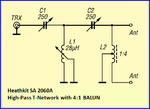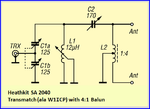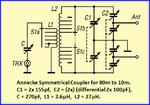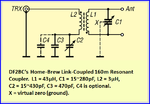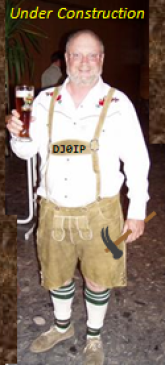MATCHBOX TECHNOLOGY SHOOT-OUT
for OPEN-WIRE-FED ANTENNAS
USING RF-CURRENT MEASUREMENTS
FOR IDENTIFYING THE BEST TECHNOLOGY
FOR MATCHING OPEN-WIRE FED ANTENNAS
WARNING: Oldtimers may get one of their past dreams << S H A T T E R E D ! >>
FORWARD
Antennas fed with "Open-Wire Feedline" (e.g., Balanced-Line, Ladder-Line, Window-Line, etc.) are becoming more and more popular amongst hams who need just one antenna to cover as many bands as possible.
Matching these antennas can be a real challenge, depending on the length of the antenna itself, as well as the length of the feedline...and the bands you want the antenna to work on.
Equipment manufacturers (OEM's) often over-hype their products, leading us to falsely believe that their 'Super-Tuner' can match anything, and do so efficiently. WRONG!
Long ago, OEM's offered many different matchbox technologies (e.g., 'Pi-Network', 'Link-Coupled Parallel', Z-Match, etc.) in addition to today's 'T-Network' and 'L-Network'.
The following information is based upon:
- Lab tests made by Tom Rauch, W8JI (no data or info from this has been uploaded here yet but he was my virtual mentor when I was studying this topic.)
- Field tests made by Alfred Klues, DF2BC.
- My own experience using various openwire fed antennas, baluns and chokes for over 50 years.
- Logical Conclusion based upon a combination of the above.
What you are about to read here is contrary to many things you may have heard in the past and especially heart-breaking for those of you who still believe that the old Johnson Viking Matchbox is the best matchbox ever for matching open-wire-fed antennas.
CASE STUDY:
Short Open-Wire-Fed Doublet (i.e. 40m Dipole used on ALL BANDS).
Clearly the antenna pictured above is a good performer on 40m and with a good antenna matchbox, it will also be a good performer on the higher bands . . .
. . . but what about 80m and 160m?
What is the best method to match this antenna on the lower bands?
- For Old-Timers, at least in the U.S.A., the answer is usually the Johnson Viking Matchbox.
- In Europe the answer is usually the ANNECKE Symmetrical Coupler.
- Fundamentally these two antenna matchboxes are the same, with a slight advantage in matching range in favor of the Annecke.
- For more information on this, see Viking vs. Annecke .
Rather than guess or express opinions, let's look at the measured results from someone who actually built the antenna and tested it with a selection of "good" antenna matchboxes.
THE ANTENNA MATCHBOXES:
- Heathkit SA-2060A; T-Network matchbox with built-in 4:1 Balun.
- Heathkit SA-2040; [Original W1ICP] Transmatch with built-in 4:1 Balun.
- Palstar BT-1500; a Symmetrical-L matchbox.
- ANNECKE Symmetrical-Koppler; a Link-Coupled symmetrical matchbox.
- DF2BC's Home-Brew High-Pass-L-Network.
- DF2BC's Home-Brew 160m Parallel Coupler.
CAUTION: The BALUN description used by Alfred is the opposite of what I use;
Where Alfred writes 1:4, I call it 4:1.
It is a transformer, so depending on how you look at it, you can call it either 1:4 or 4:1. My logic is, the name of the device is BAL:UN, thus I call it 4:1 because the BALanced side is 4x as high as the UNbalanced side.
Typically the higher impedance (4) is on the antenna side of the balun and the lower impedance (1) is on the matchbox side of the balun. (Is everyone confused now?)
Further . . .
I would not use a 4:1 balun with an antenna matchbox; I would only use a 1:1 Guanella balun!
THE ANTENNA:
MEASURED RESULTS:
As measured and recorded by Alfred Kluess, DF2BC
Published in the German FUNKAMATEUR magazine, Issue 10/2016, p. 938-941
| BAND | FREQ. [MHz] | Heathkit | Heathkit | Palstar | *Annecke | DF2BC | DF2BC - 160m | |||||||
| SA 2060A | SA 2040 | BT-1500 | Sym-Koppler | Highpass-L | Parallel-Koppler | |||||||||
| I1 [A] | I2 [A] | I1 [A] | I2 [A] | I1 [A] | I2 [A] | I1 [A] | I2 [A] | I1 [A] | I2 [A] | I1 [A] | I2 [A] | |||
| 160m | 1.810 | 1.05 | 1.05 | 1) | 1) | 2) | 2) | 1) | 1) | 2) | 2) | 2.10 | 2.10 | |
| 1.900 | 1.20 | 1.20 | 1) | 1) | 2) | 2) | 1) | 1) | 2) | 2) | 2.25 | 2.25 | ||
| 1.999 | 1.50 | 1.50 | 1) | 1) | 2) | 2) | 1) | 1) | 2) | 2) | 2.40 | 2.40 | ||
| 80m | 3.501 | 2.40 | 2.40 | 2.55 | 2.55 | 2) | 2) | 1.50 | 1.50 | 3.00 | 2.85 | |||
| 3.650 | 2.25 | 2.25 | 2.25 | 2.25 | 2) | 2) | 1.65 | 1.65 | 3.00 | 2.85 | ||||
| 3.799 | 2.10 | 2.10 | 2.10 | 2.10 | 2) | 2) | 1.80 | 1.80 | 3.00 | 2.85 | ||||
| 40m | 7.001 | 0.30 | 0.30 | 0.30 | 0.30 | 0.30 | 0.30 | 0.27 | 0.27 | 0.30 | 0.30 | |||
| 7.100 | 0.20 | 0.20 | 0.20 | 0.20 | 0.20 | 0.20 | 0.21 | 0.21 | 0.25 | 0.25 | ||||
| 7.199 | 0.20 | 0.15 | 0.20 | 0.15 | 0.15 | 0.15 | 0.15 | 0.15 | 0.20 | 0.20 | N | / A | ||
| 30m | 10.101 | 0.90 | 0.90 | 0.90 | 0.90 | 0.90 | 0.90 | 0.90 | 0.90 | 1.05 | 1.05 | |||
| 10.125 | 0.90 | 0.90 | 0.90 | 0.90 | 0.90 | 0.90 | 0.90 | 0.90 | 1.05 | 1.05 | ||||
| 10.149 | 0.90 | 0.90 | 0.90 | 0.90 | 0.90 | 0.90 | 0.90 | 0.90 | 1.05 | 1.05 | ||||
| 20m | 14.001 | 0.50 | 0.60 | 0.50 | 0.60 | 0.40 | 0.60 | 0.50 | 0.60 | 0.50 | 0.60 | |||
| 14.175 | 0.40 | 0.60 | 0.40 | 0.60 | 0.35 | 0.50 | 0.40 | 0.60 | 0.40 | 0.60 | ||||
| 14.249 | 0.30 | 0.55 | 0.30 | 0.55 | 0.30 | 0.45 | 0.35 | 0.55 | 0.35 | 0.55 | ||||
| BAND | F.[MHz] | SA-2060A | SA-2040 | BT-1500 | Annecke | Highpass-L | Parallel-Koppler | |||||||
| 17m | 18.069 | 0.50 | 0.75 | 0.60 | 0.75 | 0.90 | 0.90 | 0.90 | 0.90 | 0.90 | 0.90 | |||
| 18.118 | 0.50 | 0.75 | 0.50 | 0.75 | 0.90 | 0.90 | 0.90 | 0.90 | 0.90 | 0.90 | ||||
| 18.167 | 0.50 | 0.75 | 0.50 | 0.75 | 0.90 | 0.90 | 0.90 | 0.90 | 0.90 | 0.90 | ||||
| 15m | 21.001 | 0.75 | 0.90 | 0.90 | 0.90 | 1.05 | 1.05 | 1.05 | 1.05 | 1.20 | 1.05 | |||
| 21.225 | 0.75 | 0.90 | 0.90 | 0.90 | 0.90 | 1.05 | 1.05 | 1.05 | 1.20 | 1.05 | ||||
| 21.449 | 0.60 | 0.90 | 0.75 | 0.90 | 0.90 | 0.90 | 0.90 | 0.90 | 1.05 | 0.90 | N | / A | ||
| 12m | 24.891 | 0.30 | 0.50 | 0.40 | 0.60 | 0.70 | 0.60 | 0.70 | 0.60 | 0.50 | 0.60 | |||
| 25.940 | 0.30 | 0.50 | 0.40 | 0.60 | 0.70 | 0.60 | 0.75 | 0.60 | 0.50 | 0.60 | ||||
| 24.989 | 0.30 | 0.50 | 0.40 | 0.60 | 0.70 | 0.60 | 0.80 | 0.65 | 0.50 | 0.60 | ||||
| 10m | 28.001 | 0.30 | 1.05 | 0.45 | 1.20 | 0.60 | 0.45 | 1.20 | 1.05 | 2) | 2) | |||
| 28.850 | 0.45 | 1.20 | 0.60 | 1.20 | 0.90 | 1.20 | 1.20 | 1.05 | 2) | 2) | ||||
| 29.699 | 0.75 | 1.20 | 0.75 | 1.20 | 0.90 | 1.20 | 1.05 | 1.05 | 2) | 2) | ||||
| * 200 Watt version, very similar to the Johnson Viking 275 Watt Matchbox | ||||||||||||||
| 1) No 160m coverage foreseen | ||||||||||||||
| 2) Unable to find a match | ||||||||||||||
CAUTION: Do not try to compare the absolute current value on one band with that of another band. This is apples to oranges. The only valid comparison is across individual rows of data.
REASON: the amount of current by any given power level depends on the impedance of the antenna system it is feeding. The impedance from band to band can be all over the map, depending on antenna leg length and feedline length, and it is never the same on any two bands. (make that "almost never" - hi)
NOTES:
- Winner(s) for each band are highlighted in GREEN.
- Values highlighted in light RED have problems.
OBSERVATIONS:
160m:
- The clear winner by a mile is DF2BC's 160m Parallel-Koppler. This matchbox was described in the issue 4/2016 of FUNKAMATEUR magazine on pages 453-455.
- It not only delivered lots of current, it also maintained good symmetry between the two wires of the feedline.
- The only other matchbox that even works with this antenna on that band is the Heathkit 2060A, but it delivers only half as much RF current to the feedline as the DF2BC matchbox. Most likely this is caused by the 4:1 balun which on this band is transforming the impedance in the wrong direction. Most likely substituting a 1:1 Guanella balun would improve the results substntially.
- The Palstar covers 160m in theory but its 15uH coil is totally insufficient for matching this antenna.
- Since Pwr = I*I*R (I Squared *R), half as much currentmeans only 1/4 as much power. Thus DF2BC's matchbox delivers 4x as much power to the feedline as the Heathkit.
80m:
- The clear winner is DF2BC's High-Pass-L matchbox. This matchbox was described in issue 5/2016 of FUNKAMATEUR magazine on pages 453-455.
- It maintained fairly good symmetry, having just 5% difference in current between the two wires of the feedline.
- The ANNECKE (and presumably the Johnson Viking Matchbox) delivers only half the current that DF2BC's H-P-L delivers.
- In other words, DF2BC's H-P-L delivers 4x as much current to the feedline as does the Annecke or Johnson.
- The Palstar was unable to obtain a match on 80m! This is probably also due to insufficient inductance for matching that short of an antenna on that band.
- Though the two Heathkit have more power loss than DF2BC's matchbox, they are still efficient enough to deliver good power to the antenna on this band.
- ALL matchboxes (that worked) maintained good symmetry between the two wires of the feedline.
40m:
- As expected, the world is in good shape with this antenna on 40m. All of the matchboxes delivered good results, lots of current, and maintained fairly good symmetry on this band.
- Again DF2BC's H-P-L matchbox is the band winner, but only by a slight edge over the others.
- The two Heathkit T-Network matchboxes begin to lose a bit of symmetry on the high end of 40m.
30m:
- Here DF2BC's H-P-L again delivered the most current into the feedline, resulting in about 35% more power to the antenna.
- All other matchboxes had exactly the same results.
- All matchboxes maintained good symmetry on this band.
20m:
- The world begins to change on 20m.
- With all matchboxes, current was maximum at the bottom of the band and dropped steadily as we move up the band.
- In addition, the symmetry for all matchboxes was off by about 20% at the low end of the band, rising to about 40% at the high end. [We can only guess at the reason why. Perhaps there was something local to the antenna causing an imbalance on that band.]
- Whatever the reason, THIS IS COMMON MODE CURRENT (CMC)!
- Therefore it is important to have a balun with sufficient Common Mode Impedance (CMI) for the matchboxes using a balun.
17m:
- On 17m the two T-Network matchboxes have poor symmetry and deliver significantly less power to the antenna than the other three matchboxes.
- As such, we have 3 winners, tied for first place and two losers.
15m:
- 15m yields a similar picture to that of 17m, with three potentially good solutions and two lessor solutions (the two Heathkits).
- We do have a clear winner here, the DF2BC Highpass-L matchbox, however this is pretty much the end of the line for that technology. It's all downhill above this band.
12m:
- On 12m the DF2BC H-P-L matchbox falls behind both the link-coupled Annecke and the Palstar, significantly.
- The link-coupled Annecke is the clear winner on this band.
- Once again the two Heathkits occupy the tail end of the pack.
- Symmetry is a bit flaky with all matchboxes on this band, being 20%+ off. Again this could cause CMC issues.
10m:
- Not only is the Annecke the clear winner in efficiency here, it is also the only one maintaining a reasonable symmetry between the two wires of the feedline. We like to see symmetry within 10% of each other and in this case it is 14% off.
- The Palstar and two Heathkits have huge symmetry problems on this band. Again a warning for CMC!
- The H-P-L cannot even find a match here and is the clear loser!
CONCLUSIONS:
- For the antenna under test, is is fairly obvious that no single matchbox technology is best all the time. As with most things, it's Horses for Courses!
- Therefore it is so very important for each user to determine and define exactly what (s)he wants the antenna to do... (e.g., work better on the low bands, better on the high bands, work ALL bands (no matter what)).
- Users who spend loads of cash buying some over-hyped, over-priced antenna matchbox are going to be disapointed - no matter what! There are much simpler solutions that work just as well or better!
- Short antennas, which many of us are forced to use, do indeed have challenges, and it is apparent that modern antenna matchbox OEMs have not yet focused on that market segment.
DISCUSSION:
Note: this portion is opinionated and not necessarily gospel.
- Whenever possible, I have always strived to have two antennas, one for the low bands and one for the high bands. That was not always possible but certainly helpful for choosing a matchbox technology.
- The higher bands, which generally have higher impedance unless you have an unlucky length of feedline, seem easier to match with higher efficiency. For this you may use just about any ol' matchbox.
- The lower bands tend to be low Ohm, again depending on feedline length, and much more difficult to match. The matchboxes also have much more loss on these bands because for any given power level, you have more current flowing through the lossy components inside of the matchbox. For this reason you must carefully sellect the right technology and assure you are using hefty components to minimize losses.
- It is my opinion that when people think of deploying an antenna matchbox with openwire-fed antennas, they
are usually thinking about a symmetrical doublet and sometimes a vertical or horizontal loop antenna. What these people fail to realize is:
- 1) more and more people are using openwire to feed antennas that are more prone to Common Mode Current, such as OCFD antennas and Vertical-Dipoles.
- 2) as Alfred has shown us in his field test, sometimes antennas thought to be symmetrical and fed symmetrically can exhibit a lot of CMC, at least on some bands.
- Common Mode Current (CMC) can be a big issue, even though you think you have a symmetric antenna fed with balanced feedline. For this reason...
- . . . I continue to insist on using a 1:1 Guanella choke-balun with a toroid core having higher permeability (e.g., #43). BE AWARE that this is counter to what several gurus and all of the balun manufacturers claim.
- HOWEVER, contrary to many of them, I actually build these antennas and run high power through them. When CMC is present and there is insufficient choking . . .
. . . it is "my fingers" that get burned, not theirs!
- And what are your thoughts ? ________________________>
To be continued . . .
I know many of you are dying to find out more about the two DF2BC matchboxes.
In fact there are four or five DF2BC matchboxes, not just two.
I have full details on two of his matchboxes posted on my web, plus another "in progress", but the two used for this shoot-out are not yet uploaded. PATIENCE PLEASE.
- 160m: http://www.dj0ip.de/open-wire-fed-ant/short-antennas/short-160m-antenna/
- 80m: http://www.dj0ip.de/open-wire-fed-ant/short-antennas/short-80m-antennas/
- 40/30/20m: www.dj0ip.de/open-wire-fed-ant/short-antennas/short-40-30-20m-antenna/ My description of this switchable (series-resonant / parallel resonant) coupler is still under construction.
- Hi-Pass-L:
- 160m Resonant Coupler:
Patience please; Rome wasn't destroyed in a single day!

